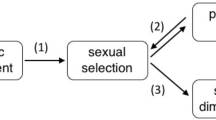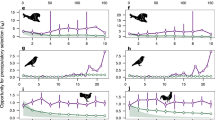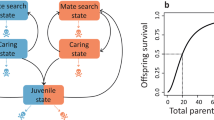Abstract
PRONOUNCED sex differences in mating competition are a prominent feature of many animal breeding systems. These differences are widely attributed to sex differences in parental investment1,2which bias the ratio of sexually receptive females to males3 (the operational sex ratio), generating more intense competition between members of one sex, usually males3–5. Unfortunately, relative parental investment1 is usually impossible to measure in species where both sexes invest in their offspring6,7 and there is currently no empirical basis for predicting the pattern of mating competition in these species. In contrast, the potential rate of reproduction by males and females (measured as the maximum number of independent offspring that parents can produce per unit time) is both more directly related to the operational sex ratio and more easily estimated in natural populations7. Here we show that among species where males care for the young, the sex with the higher potential reproductive rate competes more intensely for mates than the sex with the lower potential rate of reproduction.
This is a preview of subscription content, access via your institution
Access options
Subscribe to this journal
Receive 51 print issues and online access
$199.00 per year
only $3.90 per issue
Buy this article
- Purchase on Springer Link
- Instant access to full article PDF
Prices may be subject to local taxes which are calculated during checkout
Similar content being viewed by others
References
Trivers, R. L. in Sexual Selection and the Descent of Man (ed. B. Campbell) 136–179 (Aldlne, Chicago, 1972).
Trivers, R. L. Social Evolution (Cummings, California, 1985).
Emlen, S. T. & Oring, L. W. Science 197, 215–223 (1977).
Thornhill, R. in Evolution of Animal Behaviour: Paleontological and Field Approaches (eds Nitecki, M. H. & Hitchell, J. A.) 113–135 (Oxford University Press, Oxford, 1986).
Krebs, J. R. & Davies, N. B. An Introduction to Animal Ecology (Blackwell Scientific, Oxford, 1987).
Knapton, R. W. Can. J. Zool. 62, 2673–2674 (1984).
Clutton-Brock, T. H. The Evolution of Parental Care (Princeton University Press, New Jersey, in the press).
Gwynne, D. T. Trends Ecol. Ecol. 6, 118–121 (1991).
Gwynne, D. T. Behavl Ecol. Sociobiol. 16, 355–361 (1985).
Gwynne, D. T. & Simmons, L. W. Nature 346, 172–174 (1990).
Thornhill, R. & Gwynne, D. T. Am. Scient. 74, 382–389 (1986).
Vincent, A. C. J. thesis, Univ. Cambridge (1990).
Baylis, J. R. Nature 276, 278 (1978).
Baylis, J. R. Envir. Biol. Fish. 6, 223–251 (1981).
Breder, C. M. Jr & Rosen, D. E. Modes of Reproduction in Fishes (Natural History Press, New York, 1966).
Thresher, R. E. Reproduction in Reef Fishes (T. F. H. Publications, Neptune City, New Jersey, 1984).
Wells, K. D. in Natural Selection and Social Behavior (eds Alexander, R. D. & Tinkle, D. W.) 184–197 (Chiron Press, New York, 1981).
Nussbaum, R. A. Misc. Publs Mus. Zool. Univ. Mich. 169, 1–50 (1985).
Wilson, E. O. Insect Societies (Harvard University Press, Cambridge, Massachusetts, 1971).
Thornhill, R. & Alcock, J. The Evolution of Insect Mating Systems (Harvard University Press, Cambridge, Massachusetts, 1983).
Erckmann, W. J. thesis, Univ. Washington (1981).
Handford, P. & Mares, M. A. Biol. J. Linn. Soc. Lond. 25, 77–104 (1985).
Oring, L. W., Lank, D. B. & Maxson, S. J. Auk 100, 272–285 (1983).
Reynolds, J. D., Colwell, M. A. & Cooke, F. Behavl Ecol. Sociobiol. 18, 303–410 (1986).
Rosenqvist, G. Anim. Behav. 39, 1110–1115 (1990).
Berglund, A. Evolution (in the press).
Kluge, A. G. Misc. Publs Mus. Zool. Univ. Mich. 160, 1–170 (1981).
Kynard, B. E. Behaviour 67, 178–207 (1978).
Townsend, D. S., Am. Nat. 133, 266–272 (1989).
Oring, L. W. & Knudson, M. L. Living Bird 11, 59–73 (1972).
Berglund, A., Rosenqvist, G. & Svensson, I. Am. Nat 133, 506–516 (1989).
Berglund, A., Rosenqvist, G. & Svensson, I. Mar. Ecol. Prog Ser. 29, 209–215 (1986).
Kuwamura, T. Envir. Biol. Fish. 13, 17–24 (1985).
Bruning, D. F. Nat. Hist. 82, 68–75 (1973).
Bruning, D. F. Living Bird 13, 251–294 (1974).
Bruning, D. F. thesis. Univ. Colorado (1974).
Iwasa, Y., Odendaal, F. J., Murphy, D. D., Ehrlich, P. R. & Launer, A. E. Theor. Populat. Biol. 23, 363–379 (1983).
Gregory, P. T. Can. J. Zool. 52, 1063–1069 (1974).
Michener, G. R. Behavl Ecol. Sociobiol. 14, 29–38 (1983).
Myers, J. P. Can. J. Zool. 59, 1527–1534 (1981).
Breitwisch, R. Curr. Onithol. 6, 1–50 (1989).
Sutherland, W. J. Anim. Behav. 33, 1349–1352 (1985).
Burley, N. Proc. natn. Acad. Sci. U.S.A. 74, 3476–3479 (1977).
Burley, N. Am. Nat. 127, 415–445 (1986).
Duellman, W. E. & Trueb, L. Biology of Amphibians (McGraw-Hill, New York, 1986).
Crespo, J. thesis, Univ. Lisbon (1979).
McDiarmid, R. W. in The Development of Behavior: Comparative and Evolutionary Aspects (eds Burghardt, C. M. & Bekoff, N.) 127–147 (Garland, New York, 1978).
Smith, B. G. Biol. Bull. Mar. biol. Lab., Woods Hole 13, 5–39 (1907).
Goto, A. Copeia 1987, 32–40 (1987).
Marconato, A. & Bisazza, A. J. Fish. Biol. 33, 905–916 (1988).
DeMartini, E. E. Anim. Behav. 35, 1145–1158 (1987).
DeMartini, E. E. Copeia 1985, 966–975 (1985).
Ochi, H. Envir. Biol. Fish. 17, 117–123 (1986).
Gronell, A. M. Ethology 81, 89–122 (1989).
Barlow, G. W. Copeia 1962, 346–360 (1962).
Barlow, G. W. Z. Tierpsychol. 21, 99–123 (1964).
Unger, L. M. Behavl Ecol. Sociobiol. 13, 125–130 (1983).
Sargent, R. C. Behavl Ecol. Sociobiol. 25, 379–385 (1989).
Gale, W. F. & Deutsch, W. G. Trans. Am. Fish. Soc. 224, 220–229 (1985).
Thomson, S. Anim. Behav. 34, 580–589 (1986).
Cramp, S. et al. Handbook of the Birds of Europe, the Middle East and North Africa Vol. III (Oxford University Press, Oxford, 1983).
Ridley, M. W. Ibis 122, 210–226 (1980).
Jenni, D. A. & Collier, C. Auk 89, 743–765 (1972).
Osborne, D. R. Wilson Bull. 94, 206–208 (1982).
Osborne, D. R. & Bourne, G. R. Condor 79, 98–105 (1977).
Hoffman, A. Scop. Zool. Jahrb. Abt. Syst. Oekol. Geogr. Tiere 78, 367–403 (1949).
Hoffman, A. Orn. Ber. 2, 119–126 (1950).
Matthew, D. N. J. Bombay nat. Hist. Soc. 61, 295–301 (1964).
Urban, E. K., Fry, C. H. & Keith, S. The Birds of Africa Vol. II (Academic, New York, 1986).
Vernon, C. J. Ostrich 44, 85 (1973).
Wintle, C. C. Honeyguide 82, 27–30 (1975).
Author information
Authors and Affiliations
Rights and permissions
About this article
Cite this article
Glutton-Brock, T., Vincent, A. Sexual selection and the potential reproductive rates of males and females. Nature 351, 58–60 (1991). https://doi.org/10.1038/351058a0
Received:
Accepted:
Issue Date:
DOI: https://doi.org/10.1038/351058a0
This article is cited by
-
Validating the Revised Mating Effort Questionnaire
Archives of Sexual Behavior (2024)
-
Breeding behavior and parental care in the wild Oriental stork, Ciconia boyciana, reintroduced in Japan
Ornithology Research (2024)
-
Evidence of the active participation of women in the intergroup conflict based on the use of aggression and cooperation
Scientific Reports (2023)
-
The impact of industrial pollution on the populations of small mammals in Northern Kazakhstan
Environmental Science and Pollution Research (2023)
-
Cooperative parental performance at chick provisioning in a small passerine, the Reed Warbler Acrocephalus scirpaceus
Behavioral Ecology and Sociobiology (2023)
Comments
By submitting a comment you agree to abide by our Terms and Community Guidelines. If you find something abusive or that does not comply with our terms or guidelines please flag it as inappropriate.



